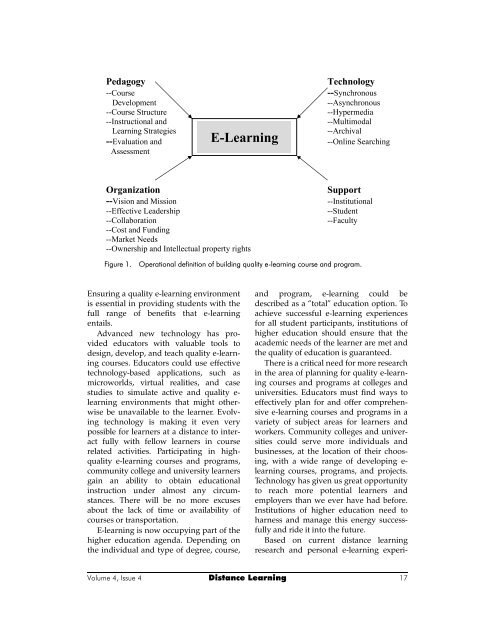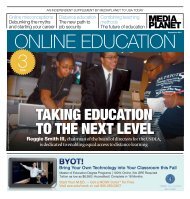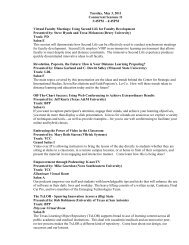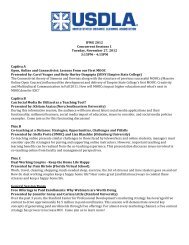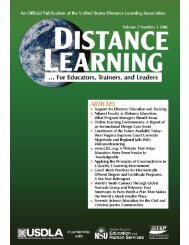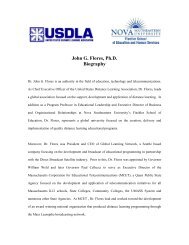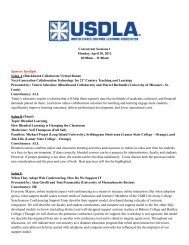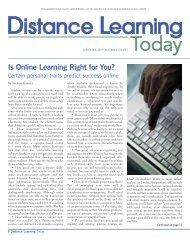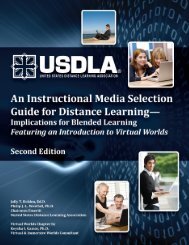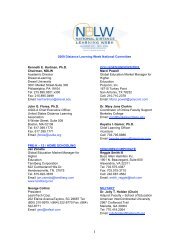United States Distance Learning Association
United States Distance Learning Association
United States Distance Learning Association
- No tags were found...
Create successful ePaper yourself
Turn your PDF publications into a flip-book with our unique Google optimized e-Paper software.
Pedagogy<br />
--Course<br />
Development<br />
--Course Structure<br />
--Instructional and<br />
<strong>Learning</strong> Strategies<br />
--Evaluation and<br />
Assessment<br />
E-<strong>Learning</strong><br />
Technology<br />
--Synchronous<br />
--Asynchronous<br />
--Hypermedia<br />
--Multimodal<br />
--Archival<br />
--Online Searching<br />
Organization<br />
--Vision and Mission<br />
--Effective Leadership<br />
--Collaboration<br />
--Cost and Funding<br />
--Market Needs<br />
--Ownership and Intellectual property rights<br />
Support<br />
--Institutional<br />
--Student<br />
--Faculty<br />
Figure 1.<br />
Operational definition of building quality e-learning course and program.<br />
Ensuring a quality e-learning environment<br />
is essential in providing students with the<br />
full range of benefits that e-learning<br />
entails.<br />
Advanced new technology has provided<br />
educators with valuable tools to<br />
design, develop, and teach quality e-learning<br />
courses. Educators could use effective<br />
technology-based applications, such as<br />
microworlds, virtual realities, and case<br />
studies to simulate active and quality e-<br />
learning environments that might otherwise<br />
be unavailable to the learner. Evolving<br />
technology is making it even very<br />
possible for learners at a distance to interact<br />
fully with fellow learners in course<br />
related activities. Participating in highquality<br />
e-learning courses and programs,<br />
community college and university learners<br />
gain an ability to obtain educational<br />
instruction under almost any circumstances.<br />
There will be no more excuses<br />
about the lack of time or availability of<br />
courses or transportation.<br />
E-learning is now occupying part of the<br />
higher education agenda. Depending on<br />
the individual and type of degree, course,<br />
and program, e-learning could be<br />
described as a “total” education option. To<br />
achieve successful e-learning experiences<br />
for all student participants, institutions of<br />
higher education should ensure that the<br />
academic needs of the learner are met and<br />
the quality of education is guaranteed.<br />
There is a critical need for more research<br />
in the area of planning for quality e-learning<br />
courses and programs at colleges and<br />
universities. Educators must find ways to<br />
effectively plan for and offer comprehensive<br />
e-learning courses and programs in a<br />
variety of subject areas for learners and<br />
workers. Community colleges and universities<br />
could serve more individuals and<br />
businesses, at the location of their choosing,<br />
with a wide range of developing e-<br />
learning courses, programs, and projects.<br />
Technology has given us great opportunity<br />
to reach more potential learners and<br />
employers than we ever have had before.<br />
Institutions of higher education need to<br />
harness and manage this energy successfully<br />
and ride it into the future.<br />
Based on current distance learning<br />
research and personal e-learning experi-<br />
Volume 4, Issue 4 <strong>Distance</strong> <strong>Learning</strong> 17


